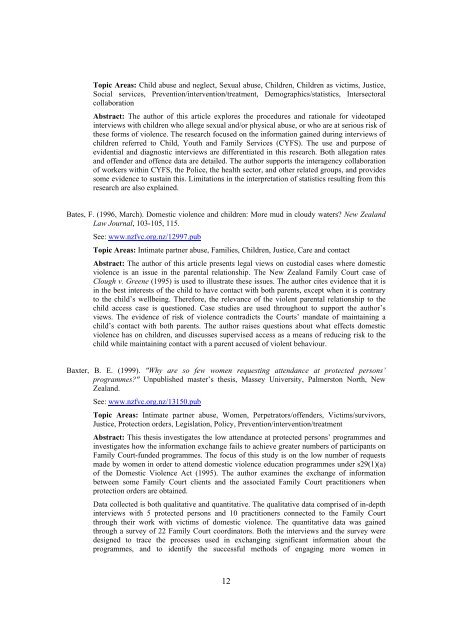annotated bibliography of new zealand research into family violence
annotated bibliography of new zealand research into family violence
annotated bibliography of new zealand research into family violence
Create successful ePaper yourself
Turn your PDF publications into a flip-book with our unique Google optimized e-Paper software.
Topic Areas: Child abuse and neglect, Sexual abuse, Children, Children as victims, Justice,Social services, Prevention/intervention/treatment, Demographics/statistics, IntersectoralcollaborationAbstract: The author <strong>of</strong> this article explores the procedures and rationale for videotapedinterviews with children who allege sexual and/or physical abuse, or who are at serious risk <strong>of</strong>these forms <strong>of</strong> <strong>violence</strong>. The <strong>research</strong> focused on the information gained during interviews <strong>of</strong>children referred to Child, Youth and Family Services (CYFS). The use and purpose <strong>of</strong>evidential and diagnostic interviews are differentiated in this <strong>research</strong>. Both allegation ratesand <strong>of</strong>fender and <strong>of</strong>fence data are detailed. The author supports the interagency collaboration<strong>of</strong> workers within CYFS, the Police, the health sector, and other related groups, and providessome evidence to sustain this. Limitations in the interpretation <strong>of</strong> statistics resulting from this<strong>research</strong> are also explained.Bates, F. (1996, March). Domestic <strong>violence</strong> and children: More mud in cloudy waters? New ZealandLaw Journal, 103-105, 115.See: www.nzfvc.org.nz/12997.pubTopic Areas: Intimate partner abuse, Families, Children, Justice, Care and contactAbstract: The author <strong>of</strong> this article presents legal views on custodial cases where domestic<strong>violence</strong> is an issue in the parental relationship. The New Zealand Family Court case <strong>of</strong>Clough v. Greene (1995) is used to illustrate these issues. The author cites evidence that it isin the best interests <strong>of</strong> the child to have contact with both parents, except when it is contraryto the child’s wellbeing. Therefore, the relevance <strong>of</strong> the violent parental relationship to thechild access case is questioned. Case studies are used throughout to support the author’sviews. The evidence <strong>of</strong> risk <strong>of</strong> <strong>violence</strong> contradicts the Courts’ mandate <strong>of</strong> maintaining achild’s contact with both parents. The author raises questions about what effects domestic<strong>violence</strong> has on children, and discusses supervised access as a means <strong>of</strong> reducing risk to thechild while maintaining contact with a parent accused <strong>of</strong> violent behaviour.Baxter, B. E. (1999). "Why are so few women requesting attendance at protected persons’programmes?" Unpublished master’s thesis, Massey University, Palmerston North, NewZealand.See: www.nzfvc.org.nz/13150.pubTopic Areas: Intimate partner abuse, Women, Perpetrators/<strong>of</strong>fenders, Victims/survivors,Justice, Protection orders, Legislation, Policy, Prevention/intervention/treatmentAbstract: This thesis investigates the low attendance at protected persons’ programmes andinvestigates how the information exchange fails to achieve greater numbers <strong>of</strong> participants onFamily Court-funded programmes. The focus <strong>of</strong> this study is on the low number <strong>of</strong> requestsmade by women in order to attend domestic <strong>violence</strong> education programmes under s29(1)(a)<strong>of</strong> the Domestic Violence Act (1995). The author examines the exchange <strong>of</strong> informationbetween some Family Court clients and the associated Family Court practitioners whenprotection orders are obtained.Data collected is both qualitative and quantitative. The qualitative data comprised <strong>of</strong> in-depthinterviews with 5 protected persons and 10 practitioners connected to the Family Courtthrough their work with victims <strong>of</strong> domestic <strong>violence</strong>. The quantitative data was gainedthrough a survey <strong>of</strong> 22 Family Court coordinators. Both the interviews and the survey weredesigned to trace the processes used in exchanging significant information about theprogrammes, and to identify the successful methods <strong>of</strong> engaging more women in12












